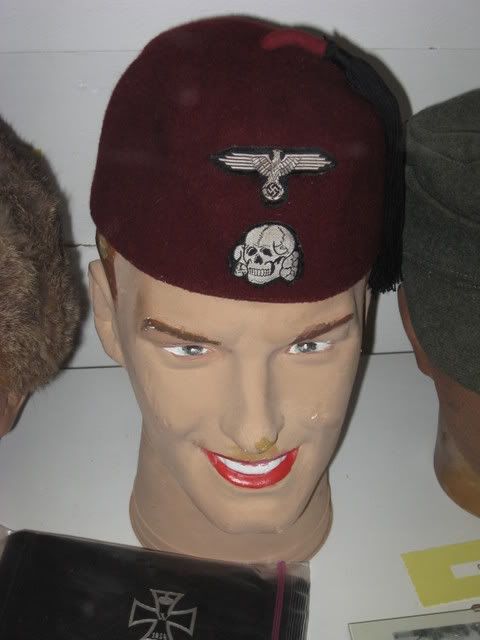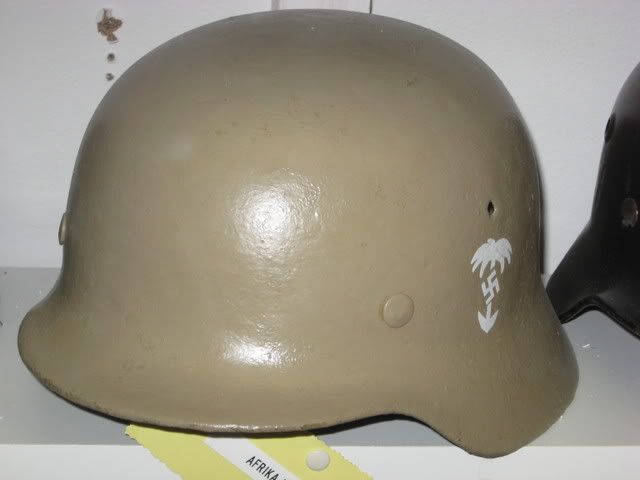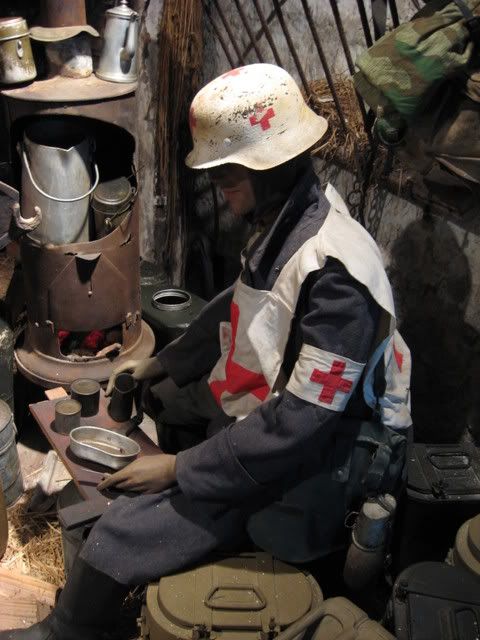Nice information…but that signature…:roll:
Check your PMs inbox.

Nice information…but that signature…:roll:
Check your PMs inbox.
Here’s a camoflauged Waffen-SS stalhelm:

And a camo Luftwaffe paratrooper helmet:

Because of the camo, that is why the US Army opted not to put camo patterns on their M1 helmets in Europe even though the USMC had camos on their helmets: It was too easy to confuse an American for a Waffen-SS trooper and vice versa.
US marine with camo helmet:

Rare example of a He-111 gunner with the steel helmet m1935 on, the luftwaffe eagle is clearly visible.

Hi Guys, new to the forum looks like an interesting place to share. I am a collector of original WWII militaria and focus primarily on Steel Helmets of German and US origin. Thought I would share some original examples of WWII German Helmets spanning a number of models implemented over the course of the war.
The first is an Example of an M42 German Steel Helmet, this was the last model implemented during the war. The edge of the helmet is left uncrimped which gives it a “raw” flared appearance. These late war helmets for the most part are undecaled due to steps taken to cut down on cost and production times. This example is HEER or regular army and a breadbag strap added for camouflage purposes (twigs, leaves were added under it)
The next Helmet, preceded the M42, it maintained the rolled edge however the two airvents were stamped instead of being a seperate grommet again for cost and production reasons. This example is again HEER or regular army however the field grey paint has been overpainted in Tan for use during the African Campaign by the DAK or more commonly known as Rommel’s Afrika Korps
Next up is the first of the new model of German Helmets and is collector known as the M35. The Shell features a rolled edge and the air vents have seperate grommets which are affixed into the shell. This helmet would have started life as a double decal helmet with a smooth apple green “parade” finish. After the polish campaign many of these helmets were refitted as single decal helmets with a rougher field grey finsh. The tricolour decal as well as the smooth shiny apple green finishes proved to give off too much glare and was obtrusive. The helmets were either sent back the factory to be refitted or the refit was completed at depot level.
The attached helmet is again a HEER issued helmet with the prominent HEER eagle (silver on black) decal affixed to the left side of the shell. This particular example was souvenired off the battle field and has been “corpse cut” as is evidenced by the wat the chinstrap has been cut as well as the blood stain on the liner. Truly a harsh example of the horrors of war
The next helmet is what we refer to as a “Transitional” helmet. These are Helmets reissued to troops prior to the development and issue of the newly designed helmet in 1935. These carry overs from the great war were meant as stop gaps until the new helmets could be made in sufficient numbers to supply the quickly growing Wehrmacht. These helmets were issued and used right up until the end of WWII
The example shown is an Austrian Made M16 shell which has been refitted with the newer liner system as seen in the M35. It is also a HEER example and has the rough texture Field Grey overpaint
The next helmet is an M42 and was issued to Feld Polizei Units (Field Police) as you may know control of these police Units fell under the Jurisdiction of the Waffen SS and many units saw bitter fighting on the Eastern Front as well as other regions. The helmet paint is again a rough finish and is the only M42 authorized to have two decals, the Bordered or unbordered Police Decal as well as the Party Shield
I hope you enjoyed seeing some of my helemts and if you have any questions about these helmets or German Helmets in General please do not hesitate to ask!
Bryan
Those are great pics Bryan! What do you consider the most valuable German helmet from WWII?
definately one of the rarest and most valuable of the WWII era helmets would be the M36 Para Helmet or one of the M35 helmets worn by the honour guard at the Felderrnhalle (hall of Field Marshalls) in Munich. Extremely rare helmets that command extraordinary prices. SS combat helmets are also scarce however there are no shortages of fakes and copies to be found
WWII helmets in general have become very collectible and are now highly faked and reproduced. Great caution should be taken in aqquiring any WWII artifact nowadays (especially German)
Regards,
Bryan
The smell of a real helmet…can that be reproduced? 
I remember going into an attic of a local museum (now closed) in my small town and seeing tons of WWII helmets, including German helmets, just scattered around on the floor. One has a swastika on the side. I never took a close look at them. I wish I did!
You would be astonished at the lengths individuals will go to “cook” up a fake helmet including literally cooking a helmet (heating in an oven) to eliminate the new paint smell… burying them outside, battery acid, etc etc fakes have become BIG business
Bryan
Um… What are those red/white/blue circles on the caps?
From what I’ve managed to learn, that symbol appears to help differentiate between Heer and Waffen-SS soldiers. A Heer soldier would have that symbol whereas a Waffen-SS grunt would have had a skull where the circle would have been.
Heer:

Waffen-SS:

A cool topic.
I would hesitate to call combat helmets “exellent protection”, however, considering most basic infantry rifle rounds could penetrate one, just like they can the modern helmet today.
And I thought the skull was the classic “Death’s Head” division?
Actually, that may be correct anyway.
http://www.scrapbookpages.com/DachauScrapbook/SScamp/SSHistory.html

That is a nice cap

favourite helmet

From 13.Waffen-Gebirgs-Division der SS “Handschar” (kroat.Nr.1)

Afrika Korps

German medic
well the german ww2 helmets must be really popular
cause in 2 days allies armies…they all got german helmets